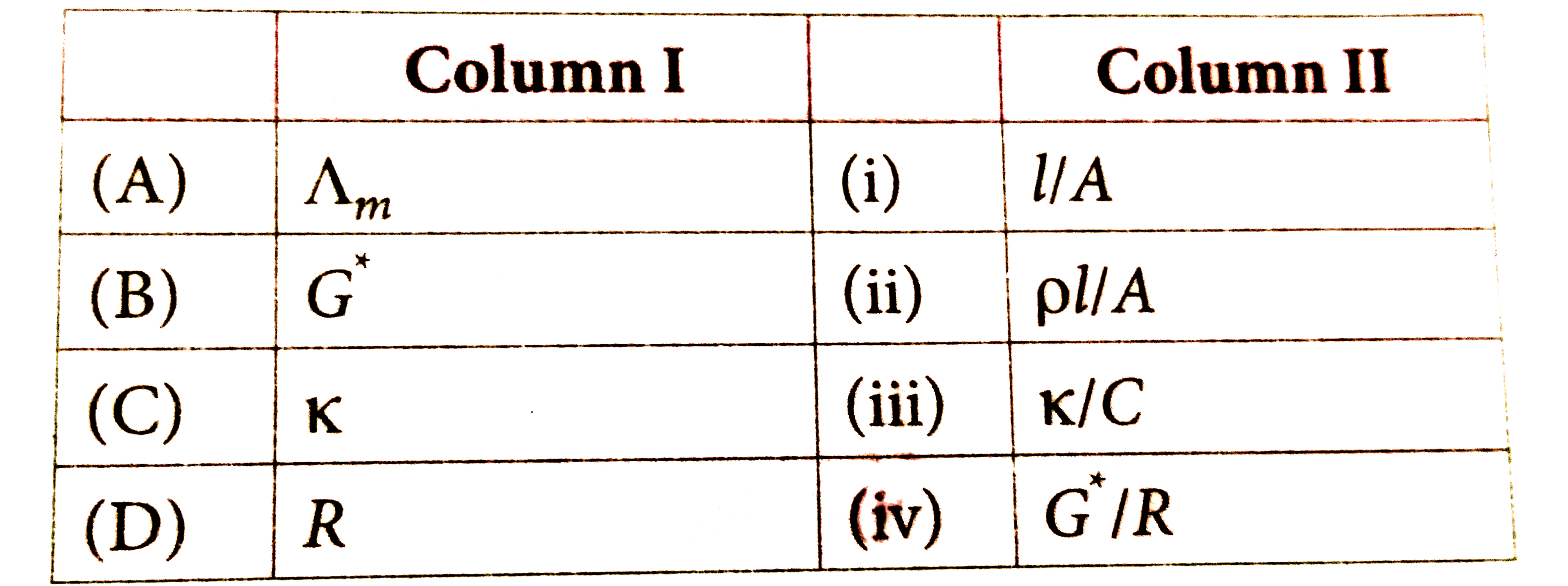Complete Solutions to Conductance Of Electrolytic Solutions of chapter ELECTROCHEMISTRY of Class 12 book with complete answers and questions
| Class 12 | CHEMISTRY |
| Chapter | ELECTROCHEMISTRY |
| NCERT FINGERTIPS | Conductance Of Electrolytic Solutions |
| Number Of Questions | 23 |
| Academic Year | 2023-24 |
The specific conductivity of N/10 KCl solution at `20^(@)C` is `0.0212 ohm^(-1) cm^(-1)` and the resistance of the cell containing this solution at `20^(@)C` is 55 ohm. The cell constant is :
View SolutionElectrical conductance through metals is called metallic or electronic conuctance and is due to the movement of electrons. The electronic conductance depends on
View SolutionFill in the blanks with appropriate words.
The electrolytic solution is always neutral because the total charge on __(i)___ is equal to __(ii)__ on ___(iii)___ .Unlike the metallic conductor, the electrolyte conducts the electric current by virtue of movement of its ___(iv)___ . The property due to which a metal tends to go into solution in term of positive ions is known as ___(v)__.
(i),(ii),(iii),(iv) and (v ) respectively are04:23View SolutionWhat would be the equivalent conductivity of a cell in which 0.5 salt solution offers a resistance of 40 ohm whose electrodes are 2 cm apart and 5 `cm^2` in area?
02:30View SolutionMatch the column I with column II and mark the appropriate choice.
 03:35View Solution
03:35View SolutionUnits of the properties measured are given below. Which of the properties has not been matched correctly?
05:47View SolutionMolar conductivity of 0.15 M solution of KCI at 298 K, if its conductivity is 0.0152 S `cm^(-1)` will be
03:28View SolutionThe molar conductivity is maximum for the solution of concentration __________.
03:51View SolutionThe specific conductance of a saturated solution of AgCl at `25^@C` is `1.821xx10^(-5)` mho `cm^(-1)`. What is the solubility of AgCl in water (in g `L^(-1)` ) , if limiting molar conductivity of AgCl is 130.26 mho `cm^(2) mol^(-1)` ?
04:54View SolutionSpecific conductance of 0.1 M NaCl solution is `1.01xx10^(-2) ohm^(-1) cm^(-1)` . Its molar conductance in `ohm^(-1) cm^(2) mol^(-1)` is
02:08View SolutionThe variation in `Lambda_m` with concentration for a strong electrolyte can be represented by the equation, `Lambda_m=Lambda_m^@ -AC^(1//2)` The value of constant A for a given solvent and temperature depends upon the type of electrolyte i.e., cations and anions produced on dissociation of electrolyte in the solution .
NaCl, `MgCl_2` and `CaSO_4` are known as05:01View SolutionThe variation in `Lambda_m` with concentration for a strong electrolyte can be represented by the equation, `Lambda_m=Lambda_m^@ -AC^(1//2)` The value of constant A for a given solvent and temperature depends upon the type of electrolyte i.e., cations and anions produced on dissociation of electrolyte in the solution .
Which of the following statements is correct regarding variations of molar conductivity with concentration.02:49View SolutionTwo solutions of X and Y electrolytes are taken in two beakers and diluted by adding 500mL of water. `Lambda_m` of X increases by 1.5 times while that of Y increases by 20 times, what could be the eletrolytes X and Y?
View SolutionWhen water is added to an aqueous solution of an electrolyte, what is the change in specific conductivity of the electrolyte?
01:53View SolutionMolar conductivity of `NH_4OH` can be calculated by the equation.
08:36View SolutionLimiting molar conductivity of NaBr is
03:55View SolutionWhat will be the molar conductivity of Al 3+ ions at infinite dilution if molar conductivity of `Al^(2) (SO_(4))_(3)` is 858 S `cm^(2)` `"mol" ^(-1)` and ionic conductance of `SO_(4)^(2-)` is 160 S `cm^(2) "mol" ^(-1)` at infinite dilution ?
03:24View SolutionLimiting molar conductivity for some ions is given below (in S `cm^(2) mol^(-1)` ) :
`Na^+ -50.1 , Cl^(-) - 76.3 , H^(+) - 349.6 , CH_3COO^(-) -40.9 , Ca^(2+) -119.0`
What will be the limiting molar conductivities `(Lambda_m^@)` of `CaCl_2, CH_3COONa ` and NaCl respectively ?View SolutionMatch the column I with column II and mark the appropriate choice.
 03:39View Solution
03:39View SolutionThe equivalent conductivity of N/10 solution of acitic acid at `25^(@)C` is `14.3 ohm^(-1) cm^(2) eq^(-1)`. Calculate the degree of dissociation of `CH_(3)COOH` if `Lambda_(oo CH_(3)COOH)` is 390.71.
02:52View SolutionThe molar conducatance of `Ba^(2+)` and `Cl^(-)` are `127` and `76 ohm^(-1) cm^(-1) mol^(-1)` respectively at infinite dilution. The equivalent conductance of `BaCl_(2)` at infinte dilution will be
02:49View SolutionThe molar conductivity of `0.025 mol L^(-1)` methanoic acid is `46.1 S cm^(2) mol^(-1)`. Its degree of dissociation `(alpha)` and dissociation constant. Given `lambda^(@)(H^(+))=349.6 S cm^(-1)` and `lambda^(@)(HCOO^(-)) = 54.6 S cm^(2) mol^(-1)`.
06:18View SolutionA weak monobasic acid is 5% dissociated in 0.01 mol `dm^(-3)` solution. The limiting molar conductivity at infinite dilution is `4.00xx10^(-2) ohm^(-1) m^(2) mol^(-1)`. Calculate the conductivity of a 0.05 mol `dm^(-3)` solution of the acid.
03:59View Solution
Conductance Of Electrolytic Solutions questions and complete solutions for chapter ELECTROCHEMISTRY of MTG CHEMISTRY (ENGLISH) of Class 12
